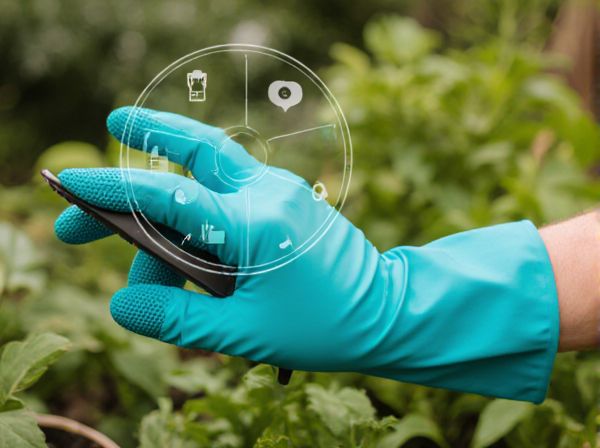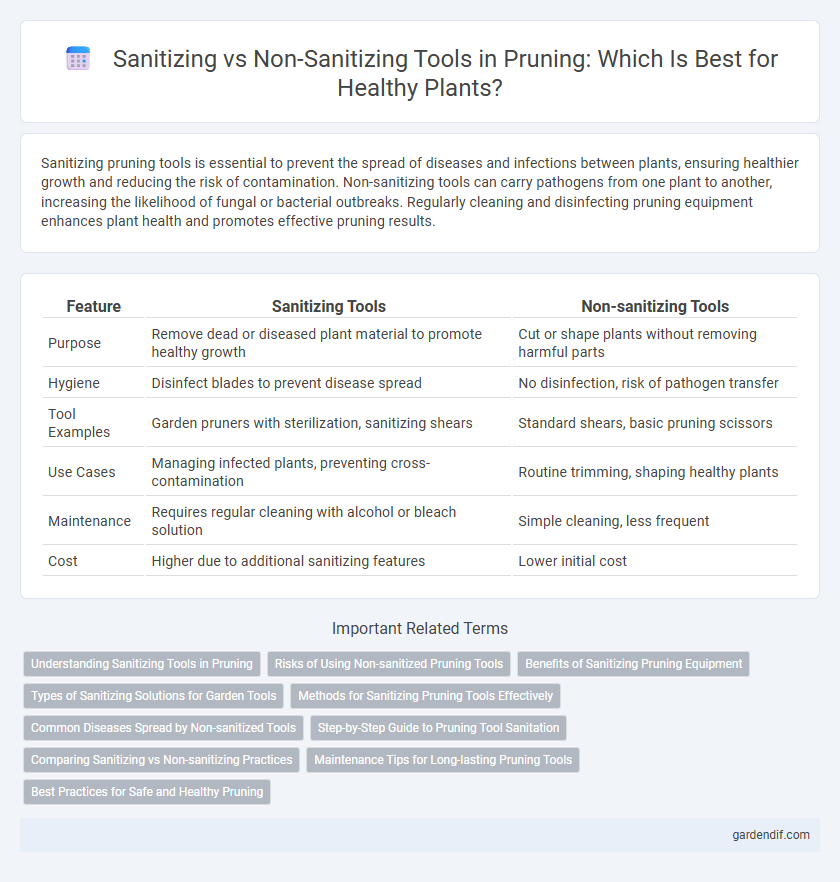
Sanitizing Tools vs Non-sanitizing Tools Illustration
Sanitizing pruning tools is essential to prevent the spread of diseases and infections between plants, ensuring healthier growth and reducing the risk of contamination. Non-sanitizing tools can carry pathogens from one plant to another, increasing the likelihood of fungal or bacterial outbreaks. Regularly cleaning and disinfecting pruning equipment enhances plant health and promotes effective pruning results.
Table of Comparison
| Feature | Sanitizing Tools | Non-sanitizing Tools |
|---|---|---|
| Purpose | Remove dead or diseased plant material to promote healthy growth | Cut or shape plants without removing harmful parts |
| Hygiene | Disinfect blades to prevent disease spread | No disinfection, risk of pathogen transfer |
| Tool Examples | Garden pruners with sterilization, sanitizing shears | Standard shears, basic pruning scissors |
| Use Cases | Managing infected plants, preventing cross-contamination | Routine trimming, shaping healthy plants |
| Maintenance | Requires regular cleaning with alcohol or bleach solution | Simple cleaning, less frequent |
| Cost | Higher due to additional sanitizing features | Lower initial cost |
Understanding Sanitizing Tools in Pruning
Sanitizing tools in pruning are essential for preventing the spread of diseases and pathogens between plants, ensuring healthier growth and higher crop yield. These tools use disinfectants such as isopropyl alcohol or bleach solutions to eliminate bacteria, fungi, and viruses from blades and shears. Proper use of sanitizing tools reduces the risk of infection and promotes sustainable, disease-resistant pruning practices.
Risks of Using Non-sanitized Pruning Tools
Using non-sanitized pruning tools significantly increases the risk of spreading plant pathogens such as bacteria, fungi, and viruses between plants, leading to diseases like blight, canker, and wilt. Contaminated tools can cause cross-contamination, resulting in decreased plant health, reduced yields, and, in severe cases, plant death. Proper sanitization with solutions like bleach or alcohol effectively mitigates these risks by eliminating harmful microbes on pruning surfaces.
Benefits of Sanitizing Pruning Equipment
Sanitizing pruning equipment reduces the risk of spreading plant diseases by eliminating harmful pathogens that can transfer from one plant to another. Clean tools promote healthier plant growth and improve overall garden productivity by minimizing infection chances. Using sanitized tools also extends the durability of pruning equipment by preventing residue build-up and corrosion.
Types of Sanitizing Solutions for Garden Tools
Sanitizing solutions for garden tools typically include bleach-based disinfectants, hydrogen peroxide, and isopropyl alcohol, each effective in eliminating pathogens like fungi, bacteria, and viruses. Bleach solutions, usually diluted to a 10% concentration, offer strong sterilization but require careful handling to prevent tool corrosion and plant damage. Hydrogen peroxide and isopropyl alcohol serve as eco-friendlier alternatives that sanitize without leaving harmful residues, making them ideal for frequent tool cleaning during pruning to reduce disease transmission.
Methods for Sanitizing Pruning Tools Effectively
Effective sanitizing of pruning tools involves using methods such as soaking blades in a 10% bleach solution or 70% isopropyl alcohol for at least 30 seconds to eliminate pathogens. Wiping tools with disinfectant wipes containing quaternary ammonium compounds or hydrogen peroxide offers an efficient alternative for rapid sanitation between cuts. Regular sharpening and cleaning of tools before disinfecting enhances the overall effectiveness of these methods, reducing the risk of disease transmission in plants.
Common Diseases Spread by Non-sanitized Tools
Non-sanitized pruning tools are a primary vector for spreading common plant diseases such as bacterial canker, fire blight, and fungal infections like powdery mildew. Contaminants on unclean tools transfer pathogens between plants, accelerating the spread of these diseases and causing significant damage to crops and orchards. Regularly sterilizing tools with alcohol or bleach solutions minimizes infection risks and promotes healthier plant growth.
Step-by-Step Guide to Pruning Tool Sanitation
Sanitizing pruning tools involves cleaning with soap and water to remove sap and dirt, followed by disinfecting with a 70% isopropyl alcohol solution or a 10% bleach mixture to eliminate pathogens. Non-sanitizing tools increase the risk of spreading diseases such as bacterial canker and fungal infections between plants. Proper tool sanitation after each cut ensures healthy plant growth and prevents cross-contamination in gardening and agricultural practices.
Comparing Sanitizing vs Non-sanitizing Practices
Sanitizing tools employ antimicrobial agents to reduce pathogens and minimize disease transmission during pruning, whereas non-sanitizing tools rely solely on physical cleanliness without chemical treatment. Studies indicate that sanitized tools significantly decrease the incidence of cross-contamination and plant infections compared to non-sanitized equipment. For optimal plant health and disease management, integrating sanitizing practices is essential in professional horticulture and agriculture.
Maintenance Tips for Long-lasting Pruning Tools
Sanitizing pruning tools by regularly cleaning with alcohol or bleach solutions prevents the spread of plant diseases and maintains blade sharpness longer. Non-sanitizing tools require more frequent sharpening and rust removal to avoid damage from sap buildup and corrosion. Proper storage in a dry environment, along with routine lubrication of moving parts, extends the lifespan of both tool types.
Best Practices for Safe and Healthy Pruning
Sanitizing tools, such as pruning shears treated with disinfectants, prevent the spread of diseases like bacterial canker and fungal infections, ensuring plant health during pruning. Non-sanitizing tools increase the risk of transmitting pathogens between plants, leading to infections that can stunt growth or cause decay. Best practices for safe pruning include regularly cleaning tools with alcohol or bleach solutions before and after use to maintain plant vitality and promote healthy regrowth.
Sanitizing Tools vs Non-sanitizing Tools Infographic

 gardendif.com
gardendif.com